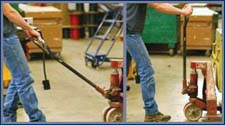Solutions for Electrical Contractors eTool
Supplemental Information » Ergonomic Principles

This index includes many general ergonomic principles that apply to this eTool and smart practices that increase productivity and decrease ergonomic risks.

Postures where the body is aligned and balanced, while sitting or standing. The head is kept upright and is not turned to either side more than about 30 degrees or tilted forward or backward more than about 15 degrees. When the worker is standing, the torso is not bent more than 10 to 20 degrees from the vertical position and the natural curves of the spine are maintained. The pelvis and shoulders should face straight ahead to avoid twisting the torso. The shoulders are relaxed and knees slightly bent. The arms hang normally at the side, with elbows close to the body. The elbows are not bent more than about 90 degrees and the palms face in toward each other and the center line of the body. The wrists are in line with the forearms and are not bent sideways, forward (towards the palm), or backward (towards the back of the hand.) When the worker is seated, the buttocks and feet are firmly supported.

Establishing a strong housekeeping program will keep the work place tidy and reduce the risk of tripping over cords and debris. It also extends the life of tools and equipment, and results in increased productivity.
Lifting properly is important. While there are some general lifting guidelines, a different approach may be needed for each load to be lifted. Sometimes it is appropriate to lift with the legs, and other times the back should be used to lift. These techniques depend on the size and shape of the load, and the frequency of lifting that is required.
Planning should be done with ergonomics in mind. Items to be planned include determining routes between staging areas and work spaces, scheduling for members of other trades, and knowing what services and utilities will be provided.

The power zone for lifting is close to the body, between mid-thigh and mid-chest height. Comparable to the strike zone in baseball, this zone is where arms and back can lift the most with the least amount of effort.

Proper handholds make lifting easier and reduce the risk of injury. Handholds should be made large enough to accommodate larger hands and should not dig into fingers and palms.

Pushing is generally preferable to pulling. Pushing allows the employee to use large muscle groups and apply more force to the load. Pulling carries a greater risk of strain and injury.
Staging is an important step in any electrical project. Proper staging includes placing materials as close as possible to work spaces, and storing materials at ideal heights so employees can utilize the power zone to take materials from storage.
Many stressors can not be engineered out of a task, short of complete automation. Rotation of assignments can be an effective means of limiting the amount of time employees are exposed to these stressors. This will often reduce the chance of injury, because the risk of injury is proportional to the amount of time one is exposed to a stressor.
Caution: Rotation of assignments should never be used before significant attempts to eliminate the stressors have been investigated. The job should always be modified to expose the employee to the least amount of stress possible. Analysis of the job is essential, because moving an employee between tasks that affect the same part of the body does not provide any periods of rest.
Rotate to jobs that affect different parts of the body or have different intensities. Many tasks primarily affect different parts of the body. Some example are:
- Lifting a heavy load.
- Repeatedly bending generally affects the low back.
- Reaching to access or to place items in positions that require the elbows to be pulled away from the body often affects the shoulder.
- Grabbing, turning, squeezing or finger strikes can affect the hand, wrist, and elbow.
- Looking down or to the side repeatedly for a prolonged time can affect the neck, head, and shoulders.
- Tasks that require standing for a long time can affect the legs, feet, and back.
Rotation of employees between tasks that affect different parts of the body allows employees to have periods of rest and recuperation while still remaining on the job. An example of a possible rotation scheme might be to move an employee who spends most of the day attaching fixtures or other overhead task to a loading and moving job where the arms are down at their sides. While on the lifting task the hands, shoulders and arms can rest if the loads lifted are not too large and proper hand holds are provided.
Work areas may have tasks of differing intensities, such as using #12 wire which requires more force exertion rather than using #14 wire which is easier to bend. Look for opportunities to rotate between tasks that are less intense and more intense.

